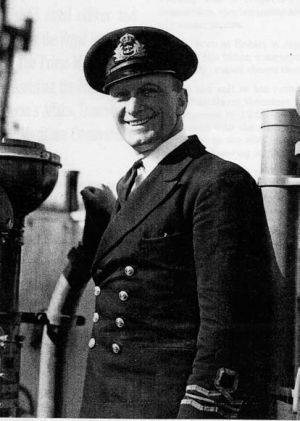- Author
- A.N. Other and NHSA Webmaster
- Subjects
- Ship histories and stories, WWII operations, Obituaries
- Tags
-
- RAN Ships
- None noted.
- Publication
- June 2003 edition of the Naval Historical Review (all rights reserved)
JUST PRIOR TO THE START of last year’s Sydney to Hobart Yacht Race a simple ceremony was conducted from the RAN diving launch Seal as the ashes of this distinguished naval officer and yachtsman were scattered off Sydney Heads. Born in Hobart and a keen yachtsman from an early age, Stan Darling joined the RANR as a 14 year old midshipman in 1925 and was an ABC radio announcer and acoustics engineer until the outbreak of WW2. At this stage he was a lieutenant commander of nearly three years seniority and on mobilisation was appointed as Assistant Staff Officer Operations, NOIC Sydney.
His interest in acoustics lead to his application for anti-submarine training at HMAS Rushcutter, which led to posting to the Royal Navy on loan service in UK waters where his seniority (despite limited sea experience) gave him command of a group of converted A/S trawlers engaged on escorting east coast convoys through the dangerous waters of ‘E Boat Alley’. The perils included sand banks, strong tides, fog and enemy E-boats, besides own and enemy minefields. He remained in command throughout the remainder of the war in trawlers (HM Ships Loch Oskaig, Inchmarnock) corvettes (HMS Clarkia) and frigates and was to prove himself remarkably successful by sinking three U-boats. Each sinking of an enemy submarine was rewarded by the award of a DSC whilst in command of the new A/S frigate HMS Loch Killin, armed with Squid (the latest deadly ahead-throwing A/S weapon) and multiple depth charges.

The first victim was U-333, destroyed in the Plymouth area on 31 July 1944 after initial detection and a well-directed attack. A week later in the same area U-736 was detected at short range and a deliberate Squid attack forced her to the surface. This time an exciting episode ensued with Loch Killin herself under torpedo attack, which was thwarted by the countermining effect of the Squid explosions. Unable to avoid a collision, Loch Killin ran over the bow section of the U-boat but managed to save her asdic dome and propellers, coming to a grinding halt. With her stern in the air and conning tower just off the port quarter the U-boat’s surviving crew members were able to clamber onboard Loch Killin without getting their feet wet!
Excitement of a different kind occurred when passing an escorted southbound convoy in the English Channel. The nearest escort, a Dance Class Admiralty trawler HMS Quadrille, failed to observe the patrolling frigate and suddenly crossed her bows. Loch Killin’s 2,300 tons hit Quadrille 700 tons hard in the engine room and cut her almost in half. Another successful engagement with a further U-boat at night off Start Point in the English Channel on 16 April 1945 claimed destruction, with three Squid salvoes which forced the submarine to the surface with a fully jammed rudder, to be finished off by the depth charge thrower.
As the war in Europe came to a close, Stan Darling was transferred to a sister ship, HMS Loch Lomond, to join the British Pacific Fleet, but the Japanese had surrendered by the time she reached Rangoon, Burma. He was relieved in Singapore in November 1945 and found himself stranded with about a dozen RAN sailors with little hope of reaching Australia by Christmas. A princely gesture by an RN destroyer sailing for Batavia took the Australians to join the aircraft carrier HMS Illustrious at 29 knots all the way, to make the connection and eventual homecoming for Christmas.
He resumed work with the ABC and his yachting interests, joining the Cruising Yacht Club of Australia in 1948, to begin a long and successful ocean-racing career, navigating five Sydney-Hobart winners between 1954 and 1970. Resumption of training with the RANR led to his promotion to Captain in 1953 (the first RANR officer to reach this rank), the award of the OBE in 1960 and retirement in 1961, completing a distinguished naval career spanning 40 years. Despite his own modesty, he remained in contact with fellow members of the A/S Officers’ Association and presented the annual prestigious Captain Stanley Darling Award to the most outstanding anti-submarine specialist student at HMAS Watson.




